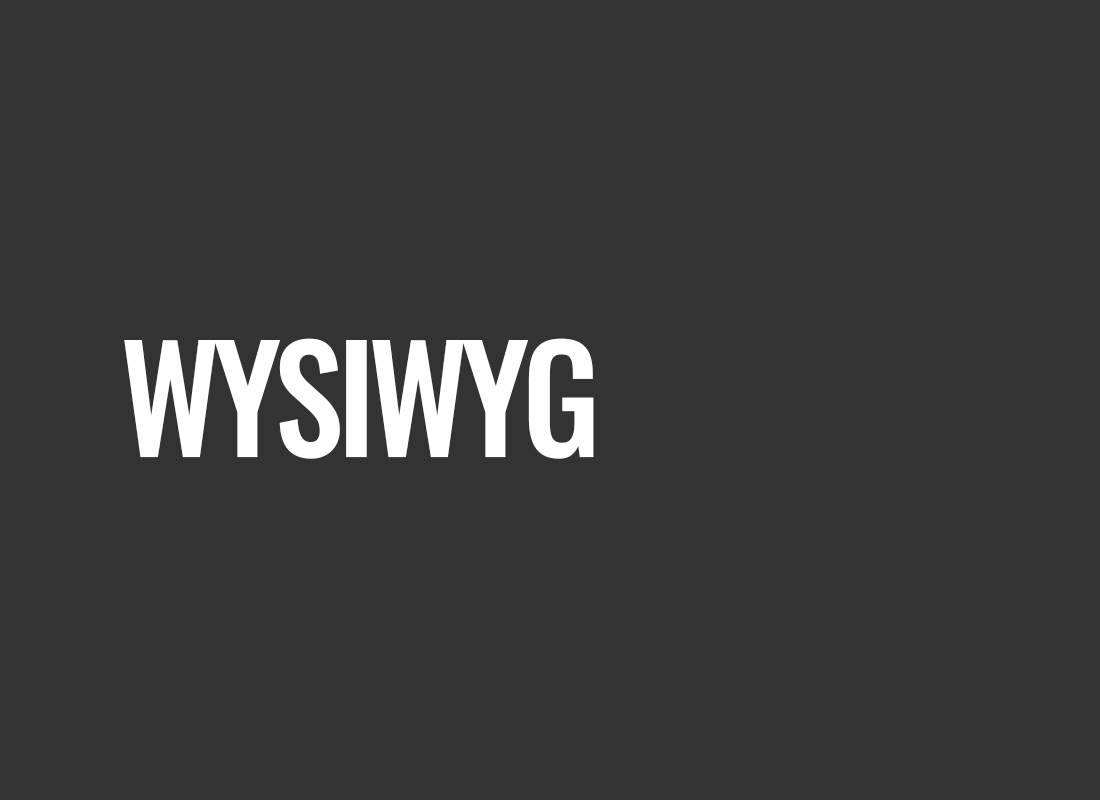WYSIWYG
In the world of technology that evolves at an incredible speed, WYSIWYG (an acronym for "What You See Is What You Get") represents a haven of simplicity for many. This concept, rooted in the early days of computing, has won users' hearts due to its clarity and transparency. But what exactly lies behind this complex acronym?
The premise of WYSIWYG is simple - users can create, edit, or modify content visually so that what they see on the screen accurately reflects what will be printed or published. Imagine working on a document where each formatting change, every added image or table, looks exactly as it will in the final version. No surprises, no technical complications. This is the promise of WYSIWYG technology.
In this context, WYSIWYG can be seen as a bridge connecting creativity with technology. It allows individuals, not technically inclined, to produce high-quality content without diving deep into intricate technical aspects. This way, what used to be the domain of coders or designers has become accessible to a broad audience. As a result, WYSIWYG has become one of the pillars of modern digital creation, democratizing content creation in the digital era.
Designing with Clarity
As technology advances and life's pace quickens, people began seeking tools to simplify their daily tasks. This is where the idea of WYSIWYG comes in. Far more than just a technological tool, WYSIWYG has become a design philosophy where clarity, simplicity, and directness are priorities.
In WYSIWYG technology, visualization is key. Users don't have to guess how their work will look upon completion. This provides a massive advantage during the design process since one can instantly see the results of their actions and make necessary adjustments in real time. In traditional methods, where editing was separate from final print or publication, surprises could arise, often requiring time-consuming corrections.
Another advantage of WYSIWYG is that it lowers the entry barrier for those wishing to produce digital content. Individuals who might have been deterred from attempting to build a website due to its complex coding can now do so with ease, focusing on visual rather than technical aspects. It also puts creativity at the forefront, enabling the production of more engaging and impressive content.
Another facet of WYSIWYG technology is its flexibility. Although initially focusing mainly on text documents, it quickly found applications in various areas, from web design to computer graphics and multimedia presentations.
However, like any technology, WYSIWYG isn't without flaws. There's a risk that users rely solely on visual tools, overlooking the more advanced capabilities a deeper understanding of the technology offers. Nonetheless, for many, WYSIWYG has become a gateway to the digital world, enabling content creation at a level previously unattainable.
Specific Uses of WYSIWYG
When we talk about WYSIWYG technology, it's worth examining how it manifests in everyday life and which tools make use of it. Here are three main examples that illustrate the versatility and potential of this approach.
1. Text Editors
Possibly the most well-known tools using WYSIWYG technology are text editors. Microsoft Word is an example. When creating a document, users can choose fonts, their sizes, colors, and add images, tables, or graphics. All of this takes place visually. Just a few clicks are needed to see the effect of our work, without thinking about how it will be coded in the background. This makes creating documents, reports, or presentations simpler and more intuitive.
2. Website Builders
The contemporary market offers a wide range of platforms for website creation, based on WYSIWYG technology. Tools such as Wix, WordPress, or Drupal allow for the creation of advanced websites without writing a single line of code. Users have a drag-and-drop interface at their disposal, where elements like images, texts, or videos can be placed exactly where desired. It's a revolutionary approach to website creation that made design accessible to a broad audience.
3. Graphic Design Tools
In the graphic industry, WYSIWYG technology has also found its place. Software like Adobe InDesign or CorelDRAW allows designers to create sophisticated graphic projects visually. Adding text, images, shapes, or colors is done directly. Designers can easily adjust their projects, being confident that what they see on the screen will precisely reflect the final print or publication.
These three examples show the diverse applications of WYSIWYG technology. From documents, through websites, to graphic projects - WYSIWYG has become an integral part of modern digital creation, offering users simplicity, intuitiveness, and assurance of the end result.
Conclusion
The need for simplicity and intuitiveness is becoming a priority. WYSIWYG, both as a tool and philosophy, plays a crucial role in shaping the modern technological landscape..
Firstly, WYSIWYG technology has democratized access to content creation. Users no longer need advanced technical knowledge to create professionally looking materials. This opens doors for a wide range of creators, from students, through bloggers, to small businesses, enabling them to create at a level previously reserved for specialists.
However, while WYSIWYG offers many benefits, it also poses some challenges. There's a risk that relying too heavily on visual editors might limit users' understanding of the deeper aspects of technology. This could lead to certain limitations, especially in more advanced projects where control over details is crucial.
Lastly, it's worth noting that although WYSIWYG has been around for decades, it continues to evolve and adapt to the changing needs of users. As technology progresses, we can expect WYSIWYG tools to become even more advanced, offering new features that continue the mission of simplifying and streamlining the creative process.
In summary, WYSIWYG technology has changed how we approach digital creation. It has bridged the gap between the user and technology, enabling creation with ease and confidence. While it comes with some challenges, its impact on the democratization of content creation is undeniable, making it one of the most critical tools in today's digital world.






